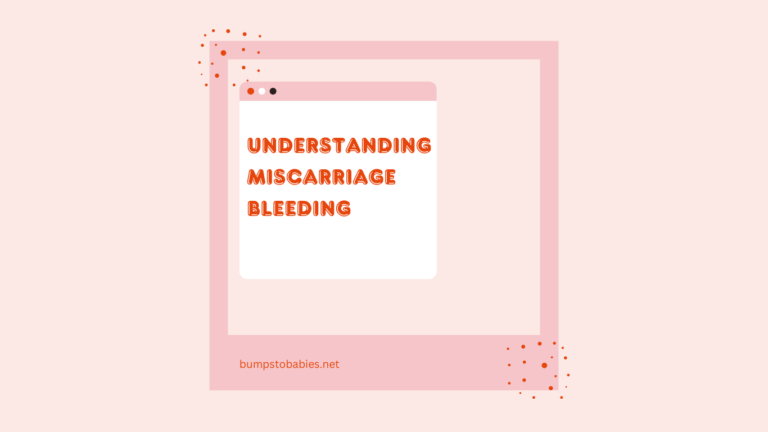Understanding Miscarriage Bleeding What Expecting Parents Need to Know
Introduction
Miscarriage is a deeply emotional and often overwhelming experience for expecting parents. The physical and emotional toll can be immense, and understanding what to expect during such a challenging time can provide some level of comfort and preparedness. This blog post aims to shed light on miscarriage bleeding, providing essential information that can help you recognize, understand, and cope with this distressing event. Expect to learn about the different types of miscarriage bleeding, what it signifies, and practical tips for managing it.
What is Miscarriage Bleeding?
Miscarriage bleeding occurs when a pregnancy ends spontaneously before the 20th week. It’s often one of the first signs that something might be wrong. The bleeding can range from light spotting to heavy flows with clots, and it’s essential to understand that the nature of the bleeding can vary widely from person to person.
Recognizing the Signs
The first step in dealing with miscarriage is recognizing the signs. These can include:
- Spotting or light bleeding that progresses to heavier bleeding
- Cramping and abdominal pain similar to menstrual cramps
- Passage of tissue or clots
- A sudden decrease in pregnancy symptoms, such as nausea or breast tenderness
Understanding these signs can help you seek medical attention promptly, which is crucial for your health and well-being.
Types of Miscarriage Bleeding
Different types of miscarriage have different bleeding patterns. It’s important to note these differences so you can better understand what’s happening to your body.
- Threatened Miscarriage
A threatened miscarriage involves light spotting or bleeding without cervical dilation. The pregnancy may still continue despite these symptoms.
- Inevitable Miscarriage
In an inevitable miscarriage, the bleeding is heavier, and the cervix is already dilated. This type indicates that pregnancy loss is unavoidable.
- Incomplete Miscarriage
An incomplete miscarriage involves heavy bleeding and cramping, with some pregnancy tissue remaining in the uterus.
- Complete Miscarriage
This type involves the complete expulsion of pregnancy tissues, leading to heavy bleeding followed by a gradual tapering off.
- Missed Miscarriage
A missed miscarriage may not involve noticeable bleeding initially. The pregnancy has ended, but the tissue hasn’t yet expelled.
When to Seek Medical Help
While some bleeding can be normal in early pregnancy, it’s crucial to know when to seek medical help. If you experience heavy bleeding, severe cramping, dizziness, or fever, contact your healthcare provider immediately. These could be signs of complications that need urgent attention.
Emotional Impact and Coping Strategies
The emotional impact of a miscarriage can be devastating. It’s essential to acknowledge your feelings and seek support from loved ones or professionals. Joining a support group, talking to a counselor, or simply allowing yourself to grieve can be beneficial steps in the healing process.
How to Manage Miscarriage Bleeding
Managing miscarriage bleeding involves both physical and emotional care. Here are some practical tips:
- Rest and Hydration: Ensure you get plenty of rest and stay hydrated to support your body’s healing process.
- Pain Management: Over-the-counter pain relievers can help manage cramps and discomfort. Always consult with your healthcare provider before taking any medication.
- Monitor Bleeding: Keep track of the amount and type of bleeding. This information can be helpful for your healthcare provider.
Miscarriage Bleeding vs. Implantation Bleeding
It’s essential to differentiate between miscarriage bleeding and implantation bleeding. Implantation bleeding occurs when the fertilized egg attaches to the uterine lining and is usually lighter and shorter in duration.
Importance of Follow-Up Care
After a miscarriage, follow-up care is crucial. Your healthcare provider may perform an ultrasound to ensure that all pregnancy tissue has been expelled and to check for any complications. Follow their recommendations for physical rest and emotional support.
Preventive Measures and Future Pregnancies
While many miscarriages are beyond anyone’s control, taking care of your health can positively impact future pregnancies. Maintain a healthy lifestyle, avoid harmful substances, and attend regular prenatal check-ups to monitor your health and your baby’s development.
FAQ about Miscarriage Bleeding
- Is it normal to have heavy bleeding during a miscarriage?
Heavy bleeding can be typical during a miscarriage, but if it’s excessive, seek medical help immediately.
- How long does miscarriage bleeding last?
The duration can vary, typically lasting a few days to several weeks.
- Can I get pregnant again after a miscarriage?
Yes, many women conceive successfully after a miscarriage. It’s essential to give your body time to heal and discuss your plans with your healthcare provider.
Conclusion
Experiencing miscarriage bleeding is a challenging and emotional ordeal. Understanding the types, recognizing the signs, and knowing when to seek help can make a significant difference in how you cope. Remember, you’re not alone—seek support from loved ones and professionals, and take the necessary steps to care for your physical and emotional well-being. For more personalized advice and support, don’t hesitate to schedule a consultation with your healthcare provider.
Join Our Community!
Are you looking for support, advice, or just a friendly chat about pregnancy and parenting? Join our community on Facebook! Connect with other parents, share your experiences, and get answers to all your questions.
Additional Resources
For more information on pregnancy complications and what to look out for, you can visit our detailed guide on pregnancy complications. This resource provides comprehensive insights on various issues that might arise during pregnancy and how to manage them.


Comments are closed.